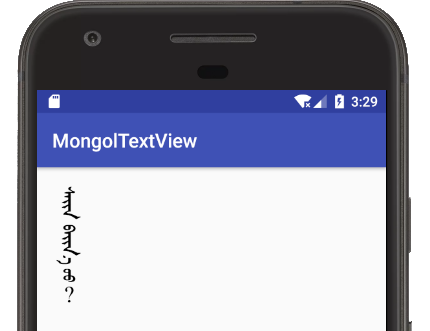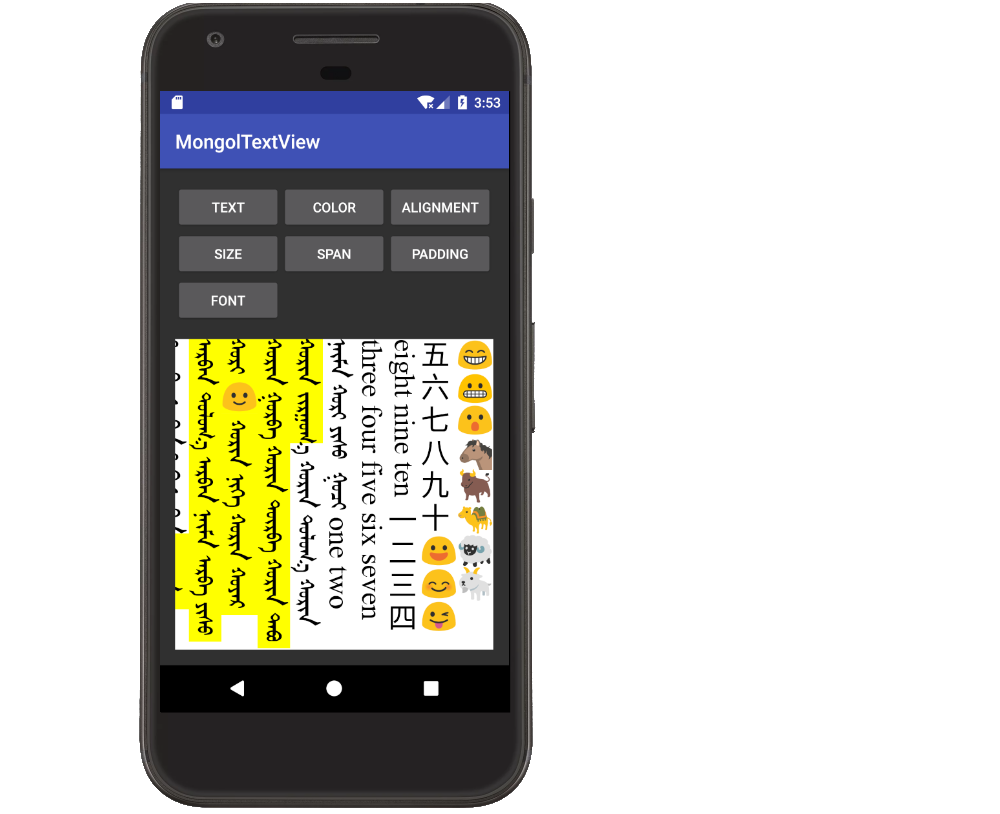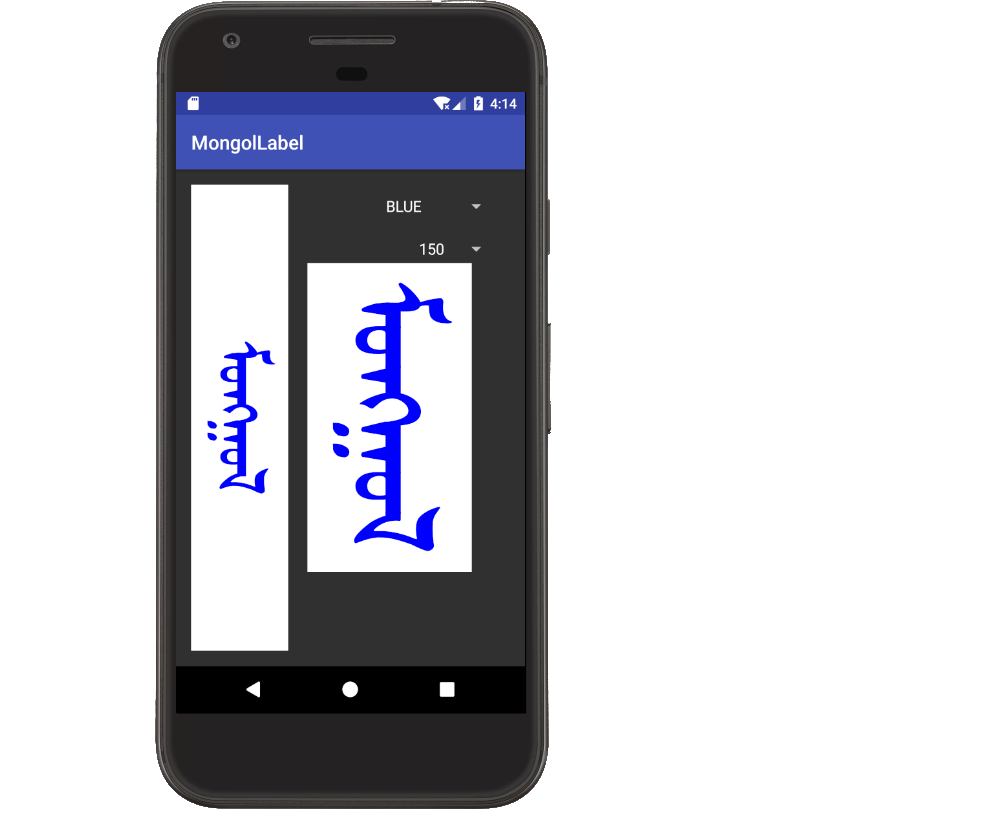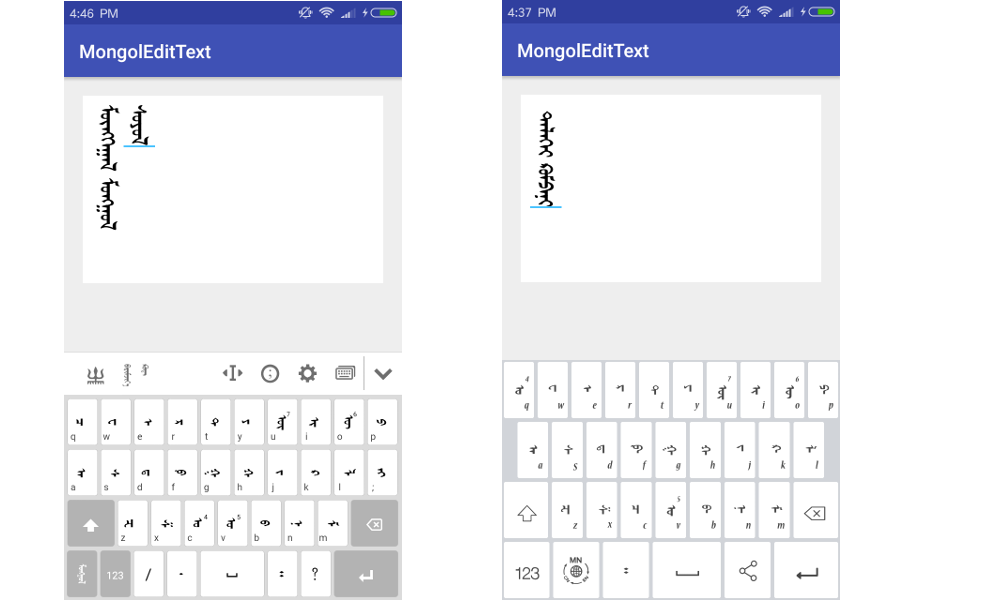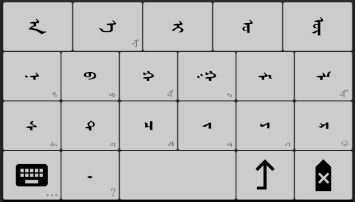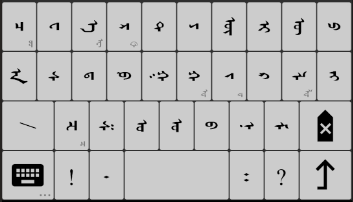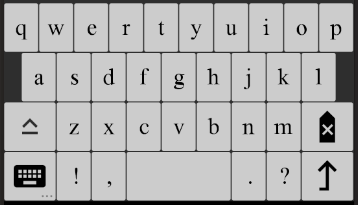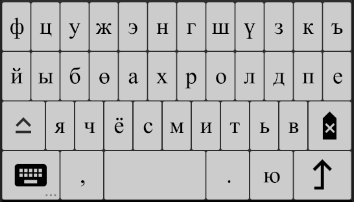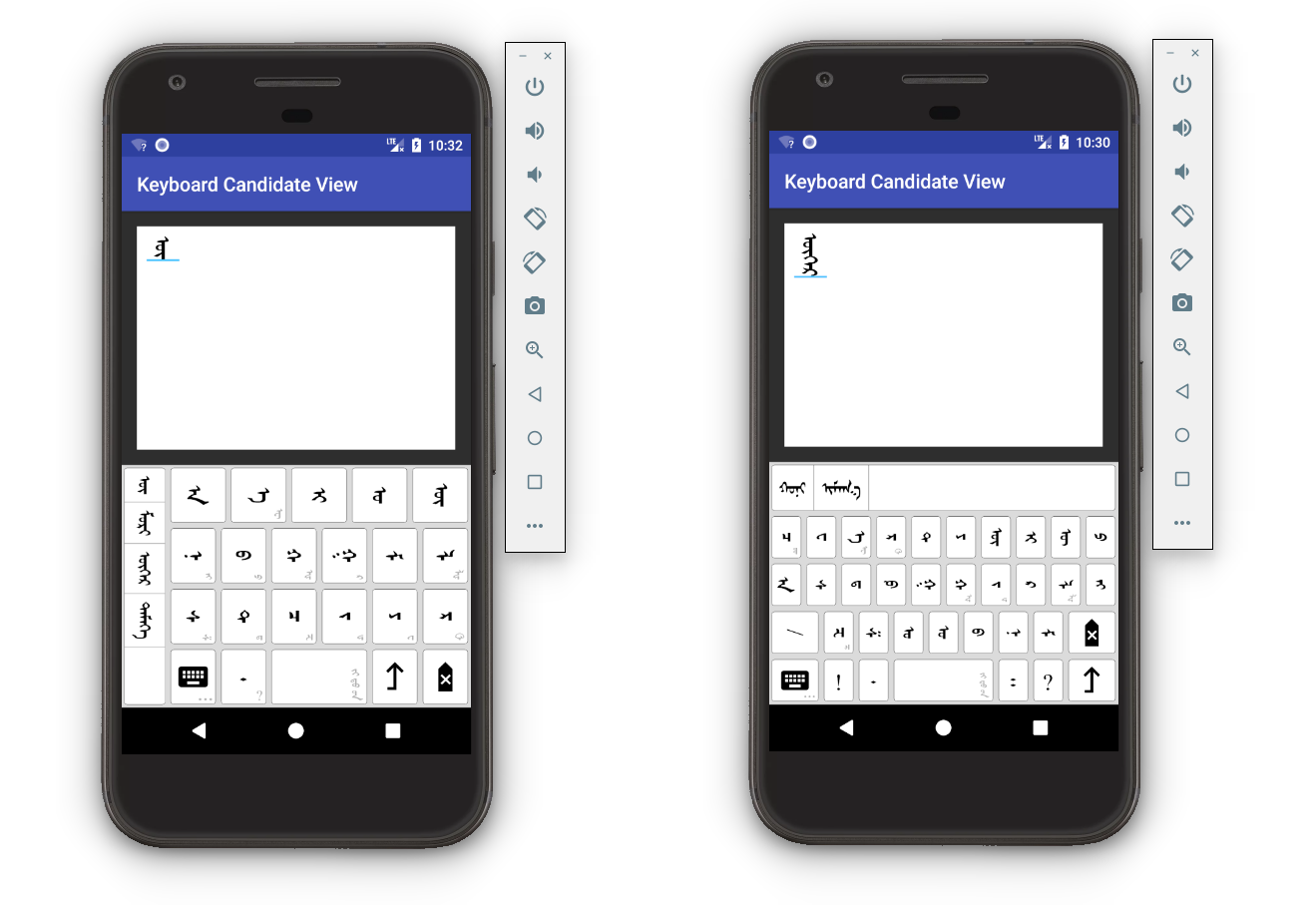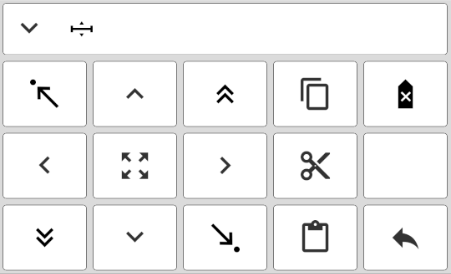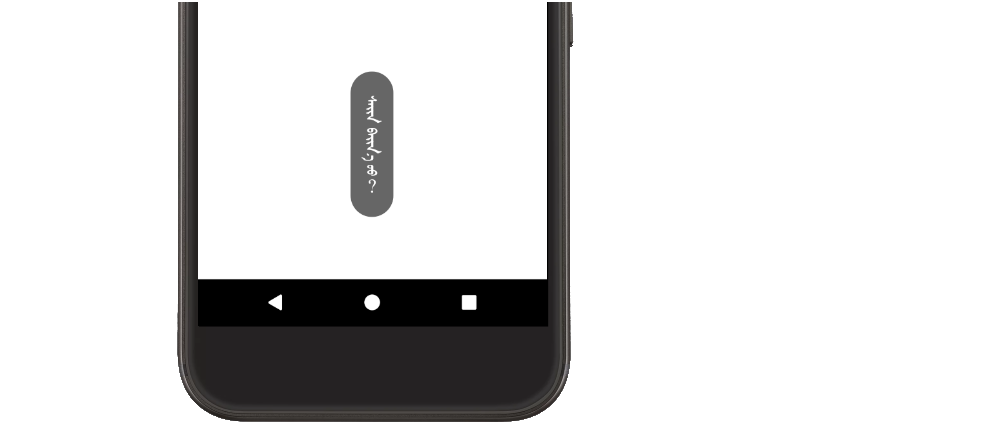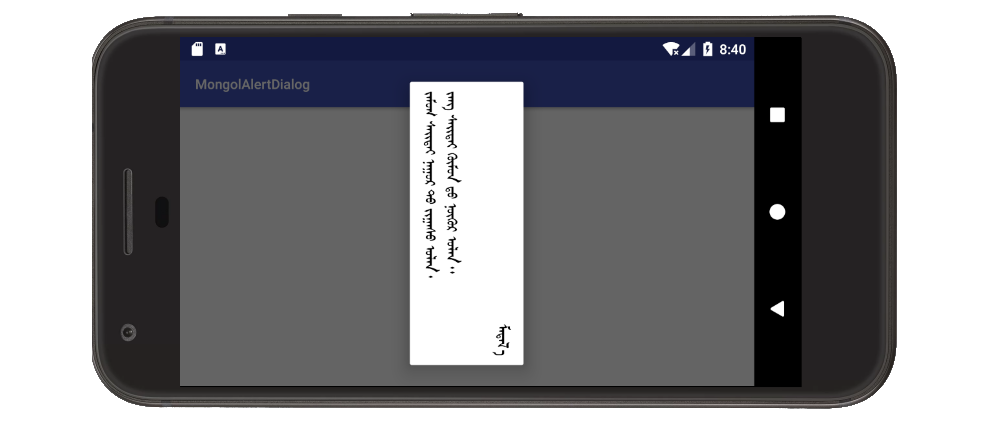Android UI components for vertical Mongolian text
- Introduction
- Installing
- UI Components
- Unicode
- Fonts
- How to contribute
- External links
- Apps that use this library
This Android library is a collection of UI components that support vertical Mongolian text.
All of the native Android UI components only support horizontal text. In addition to this, Android support for Mongolian Unicode rendering is inadequate. These challenges are a big hurdle for new Mongolian app developers to overcome. This makes the Mongolian app development process very slow.
The purpose of this library is to make it easy to include vertical Mongolian text in your app. You only need to import the mongol-library module.
This library is a part of the jCenter repository, which is the default in Android Studio.
You can import mongol-library into your project from jCenter by adding the following line to your dependencies in your app module's build.gradle file:
dependencies {
implementation 'net.studymongolian:mongol-library:2.1.0'
}If you not using the AndroidX support library, then use the following import instead:
implementation 'net.studymongolian:mongol-library:1.17.3'- The minimum SDK version for this library is 14. So if you are supporting Android versions below API 14 (Android 4.0 Icecream Sandwich), then you won't be able to use this library.
- Beginning with version
2.0.0, this library uses semantic versioning.
The following are the primary UI components in the library. See also the Demo App for an example of how they are used.
The MongolTextView is a vertical text replacement for the standard Android TextView. It measures and lays out text from top to bottom and vertical lines are laid out from left to right. No mirroring is done internally so mirrored fonts are not required (if you want to add additional fonts). As much as possible the API seeks to follow the standard TextView API.
You can create a MongolTextView exclusively in XML or in code.
XML example
<LinearLayout
xmlns:android="http://schemas.android.com/apk/res/android"
xmlns:app="http://schemas.android.com/apk/res-auto"
android:layout_width="match_parent"
android:layout_height="match_parent"
android:padding="20dp">
<net.studymongolian.mongollibrary.MongolTextView
android:id="@+id/mongol_text_view_id"
android:layout_height="wrap_content"
android:layout_width="wrap_content"
app:text="ᠰᠠᠢᠨ ᠪᠠᠢᠨᠠ ᠤᠤ︖"
app:textSize="24sp"
app:textColor="@android:color/black"/>
</LinearLayout>If you are defining a style in xml, then don't use the android or app namespace for any of the custom attributes:
<style name="AppTheme.MongolTextStyle">
<item name="android:layout_width">wrap_content</item>
<item name="android:layout_height">wrap_content</item>
<item name="android:layout_centerInParent">true</item>
<item name="textColor">@color/my_text_color</item>
<item name="textSize">24sp</item>
</style>Code example
public class MainActivity extends AppCompatActivity {
@Override
protected void onCreate(Bundle savedInstanceState) {
super.onCreate(savedInstanceState);
setContentView(R.layout.activity_main);
MongolTextView mongolTextView = findViewById(R.id.mongol_text_view_id);
mongolTextView.setText("ᠮᠣᠩᠭᠣᠯ");
mongolTextView.setTextColor(Color.BLUE);
}
}Other features of MongolTextView include the following:
- Text color
- Text size
- Font
- Alignment
- Padding
- Spans
- Background color
- Foreground color
- Relative size
- Typeface
- Style
- Subscript
- Underline
- Clickable
- (and any other span that implements
CharacterStyleshould also work)
- (TODO line spacing)
- Emoji support
- CJK orientation support
- Unicode support
These can be further explored with the Demo App.
MongolLabel is a light weight view similar to MongolTextView. It is less expensive because it does not have to calculate multi-line, emoji rotation, or spans. If you need a large number of MongolTextViews and are experiencing performance problems, then this may be a solution.
Supports:
- Unicode
- text color
- text size
- fonts (typeface)
- centered in view
- auto text resizing if font too big for view size
Does not support:
- multi-line text
- CJK/emoji rotation
- text spans
Here is an image of the Demo App:
The MongolEditText is a vertical text replacement for the standard Android EditText. As much as possible the API seeks to follow the standard EditText API. It subclasses MongolTextView. In addition to allowing cursor location and text selection, it also adds the API elements needed to communicate with both custom in-app keyboards and system keyboards.
Long clicking the MongolEditText will display a default MongolMenu with editing options. This menu can also be replaced with a custom menu if you implement setContextMenuCallbackListener().
The following image shows MongolEditText receiving text input from the Menksoft and Delehi system keyboards.
<RelativeLayout xmlns:android="http://schemas.android.com/apk/res/android"
xmlns:app="http://schemas.android.com/apk/res-auto"
android:layout_width="match_parent"
android:layout_height="match_parent"
android:padding="20dp">
<HorizontalScrollView
android:id="@+id/hsvEditTextContainer"
android:layout_width="match_parent"
android:layout_height="wrap_content"
android:fillViewport="true">
<net.studymongolian.mongollibrary.MongolEditText
android:id="@+id/metExample"
android:layout_width="wrap_content"
android:layout_height="200dp"
android:padding="10dp"
android:background="@android:color/white"
app:text=""
app:textSize="30sp"/>
</HorizontalScrollView>
</RelativeLayout>Note that since MongolEditText does not support scrolling itself yet, it is good to wrap it in a HorizontalScrollView. If you need only a single line then you can wrap it in a ScrollView. A future TODO may be to add a singleLine or maxLines attribute.
MongolEditText mongolEditText = findViewById(R.id.metExample);
String text = mongolEditText.getText().toString();- Accepts input from system keyboards and mongol-library keyboards.
- text selection
- highlight words on double click
- change selection on drag
- conforms to the Editable protocol
- Unicode indexing (handles glyph indexing internally)
- also supports Menksoft code
It cannot be assumed that all users will have a Mongol IME (like the Menksoft or Delehi keyboards) installed on their phone, so if you need Mongolian input in your app, you should probably include an in-app keyboard.
This library includes four keyboard layouts: two traditional Mongolian ones (AEIOU and QWERTY) and Cyrillic and Latin keyboards. Punctuation is shown by clicking the keyboard button. Keyboard layouts can be switched by long pressing the keyboard button.
The philosophy behind the AEIOU keyboard is to make input as easy as possible. The general arrangement follows the order of the Mongolian alphabet. The buttons are large by making infrequently used letters only available as longpress popups. The Unicode distinctions between O/U, OE/UE, and T/D are hidden from the user. It has been reported that countryside Mongols who have less interaction with computer keyboards prefer this layout. Users who want more controll over the Unicode input characters can use the QWERTY keyboard layout.
This keyboard copies the layout of a computer keyboard (with the addition of Mongolian Unicode ANG). Users can differentiate O/U, OE/UE, and T/D.
Is is possible to use your own custom keyboard layout. You just need to extend Keyboard and implement the appropriate methods. Start with a copy of the source code for one of the library keyboards and modify it to suite your needs. An example of a custom keyboard is included in the Demo App.
The keyboards are added to an ImeContainer to allow for keyboard switching and candidate word suggestions. This can be done programmatically or in XML. However, if you want to style your keyboard, you must do it in XML.
XML layout
<?xml version="1.0" encoding="utf-8"?>
<RelativeLayout
xmlns:android="http://schemas.android.com/apk/res/android"
xmlns:app="http://schemas.android.com/apk/res-auto"
xmlns:tools="http://schemas.android.com/tools"
android:layout_width="match_parent"
android:layout_height="match_parent">
<HorizontalScrollView
android:id="@+id/hsvEditTextContainer"
android:layout_width="match_parent"
android:layout_height="match_parent"
android:layout_alignParentEnd="true"
android:layout_alignParentRight="true"
android:layout_alignParentTop="true"
android:layout_above="@id/ime_container"
android:layout_margin="16dp"
android:fillViewport="true">
<net.studymongolian.mongollibrary.MongolEditText
android:id="@+id/mongoledittext"
android:layout_width="wrap_content"
android:layout_height="match_parent"
android:background="@android:color/white"
android:padding="10dp"
app:textSize="30sp"
tools:layout_editor_absoluteX="20dp"
tools:layout_editor_absoluteY="128dp" />
</HorizontalScrollView>
<net.studymongolian.mongollibrary.ImeContainer
android:id="@+id/ime_container"
android:layout_width="match_parent"
android:layout_height="250dp"
android:background="#dbdbdb"
android:layout_alignParentBottom="true"
android:layout_alignParentStart="true"
android:layout_alignParentEnd="true"
android:layout_alignParentLeft="true"
android:layout_alignParentRight="true">
<net.studymongolian.mongollibrary.KeyboardQwerty
android:layout_width="match_parent"
android:layout_height="match_parent"
style="@style/KeyboardTheme"
/>
<net.studymongolian.mongollibrary.KeyboardAeiou
android:layout_width="match_parent"
android:layout_height="match_parent"
app:primaryTextSize="30sp"
style="@style/KeyboardTheme"
/>
</net.studymongolian.mongollibrary.ImeContainer>
</RelativeLayout>You could style each keyboard separately, but in the above example a single style is used.
<style name="KeyboardTheme" parent="AppTheme">
<item name="keyColor">#ffffff</item>
<item name="keyPressedColor">#b3b3b3</item>
<item name="primaryTextColor">#000000</item>
<item name="secondaryTextColor">#b3b3b3</item>
<item name="keySpacing">3dp</item>
<item name="keyBorderWidth">1px</item>
<item name="keyBorderColor">#000000</item>
<item name="keyBorderRadius">3dp</item>
<item name="popupTextColor">#fe9a52</item>
<item name="popupHighlightColor">#dbdbdb</item>
</style>Code
public class MainActivity extends AppCompatActivity {
@Override
protected void onCreate(Bundle savedInstanceState) {
super.onCreate(savedInstanceState);
setContentView(R.layout.activity_keyboard);
ImeContainer imeContainer = findViewById(R.id.ime_container);
MongolEditText mongolEditText = findViewById(R.id.mongoledittext);
// The MongolInputMethodManager handles communication between the
// ImeContainer (keyboards) and the MongolEditText (or EditText).
MongolInputMethodManager mimm = new MongolInputMethodManager();
mimm.addEditor(mongolEditText);
mimm.setIme(imeContainer);
}
}You can provide word suggestions in a candidates view while the user is typing. You will need to suply your own word database, though.
To do this you need to set KeyboardCandidateView location in XML for each keyboard that is using it.
<net.studymongolian.mongollibrary.KeyboardQwerty
...
app:candidatesLocation="horizontal_top"
...
/>
<net.studymongolian.mongollibrary.KeyboardAeiou
...
app:candidatesLocation="vertical_left"
...
/>The candidates view uses a RecyclerView internally, so you should include it in your app's build.gradle dependencies.
dependencies {
implementation 'com.android.support:recyclerview-v7:27.1.1'
}The system keyboard will popup natually so you can prevent that by hiding in the Manifest for the activity that is using the keyboard.
android:windowSoftInputMode="stateHidden"Then implement ImeContainer.DataSource in your activity to provide the requested word suggestion list. Implement ImeContainer.OnNonSystemImeListener to hide the keyboard when requested from the navigation view.
public class MyActivity extends AppCompatActivity implements ImeContainer.DataSource, ImeContainer.OnNonSystemImeListener {
@Override
protected void onCreate(Bundle savedInstanceState) {
// ...
// provide words for candidate selection
imeContainer.setDataSource(this);
// listen for when keyboard requests to be hidden
imeContainer.setOnNonSystemImeListener(this);
// ...
}
// ImeContainer.DataSource methods
@Override
public void onRequestWordsStartingWith(String text) {
// query database for words starting with `text`
// call `imeContainer.setCandidates(wordList)` after the results come back
}
@Override
public void onWordFinished(String word, String previousWord) {
// save/update `word`
// optionally update `previousWord`'s following
}
@Override
public void onCandidateClick(int position, String word, String previousWordInEditor) {
// query database for words that can follow `word`
// call `imeContainer.setCandidates(wordList)` after the results come back
// optionally update database word frequency and following
}
@Override
public void onCandidateLongClick(int position, String word, String previousWordInEditor) {
// user long clicked a candidate item
}
@Override
public void onHideKeyboardRequest() {
// set the ImeContainer visibility to View.GONE
}
}This is what the navigation view looks like:
MongolMenu is a replacement for context menus and toolbar menus.
MongolMenu menu = new MongolMenu(this);
menu.add(new MongolMenuItem("ᠨᠢᠭᠡ", R.drawable.ic_sun));
menu.add(new MongolMenuItem("ᠬᠤᠶᠠᠷ", R.drawable.ic_moon));
menu.add(new MongolMenuItem("ᠭᠤᠷᠪᠠ", R.drawable.ic_star));
menu.setOnMenuItemClickListener(new MongolMenu.OnMenuItemClickListener() {
public boolean onMenuItemClick(MongolMenuItem item) {
MongolToast.makeText(MongolMenuActivity.this, item.getTitle(), MongolToast.LENGTH_SHORT).show();
return true;
}
});
menu.showAsDropDown(view, 0, 0);Instead of showAsDropDown (which anchors it to the view), you can also use showAtLocation to place it anywhere on the screen. Here is an example that places it on the toolbar.
MongolToast is a vertical version of Android Toast.
MongolToast.makeText(getApplicationContext(), "ᠰᠠᠢᠨ ᠪᠠᠢᠨᠠ ᠤᠤ︖", MongolToast.LENGTH_LONG).show();This produces the following result:
MongolAlertDialog is a vertical version of Android AlertDialog. It currently only supports a title, message, and up to 3 buttons.
// setup the alert builder
MongolAlertDialog.Builder builder = new MongolAlertDialog.Builder(this);
builder.setMessage("ᠵᠠᠮᠤᠭ ᠰᠠᠢᠲᠠᠢ ᠨᠠᠭᠤᠷ ᠲᠤ ᠵᠢᠭᠠᠰᠤ ᠤᠯᠠᠨ᠂\nᠵᠠᠩ ᠰᠠᠢᠲᠠᠢ ᠬᠦᠮᠦᠨ ᠳᠦ ᠨᠦᠬᠦᠷ ᠤᠯᠠᠨ᠃");
// add the button
builder.setPositiveButton("ᠮᠡᠳᠡᠯᠡ", new DialogInterface.OnClickListener() {
@Override
public void onClick(DialogInterface dialog, int which) {
// do sth
}
});
// create and show the alert dialog
MongolAlertDialog dialog = builder.create();
dialog.show();This produces the following result:
No special UI componants are needed from the library to create a horizontal RecyclerView. However, it is a common need for Mongolian apps, so an example is included here.
The only thing you really need to do differently from a normal RecyclerView list is to use LinearLayoutManager.HORIZONTAL for the orientation. Check out this Stack Overflow answer for more detailed instructions.
Also see the example in the Demo App. Here is the relevant code:
- HorizontalRecyclerViewActivity.java
- HorizontalRecyclerViewAdapter.java
- activity_horizontal_recyclerview.xml
- horizontal_recyclerview_item.xml
All of the UI components in this library are designed to use Unicode for all input and output. (However, since glyph rendering internally uses Menksoft code, you can also use Menksoft code for input. This is not recommended, though.)
The MongolCode rendering engine seeks to conform to the Unicode 10.0 standard (Mongolian Block). However, the standard was deviated from in the following two cases:
-
MONGOLIAN LETTER GA, second final form. The Unicode 10.0 standard second final form is the feminine form. However, there is no way to override a feminine GA in words like SHIG to make it masculine and the only solution is to explicitly specify a feminine GA in every single neuter word (example: BICHIG(FVS1)). However, none of the major font players do that (source). They use FVS1 as a masculine override and FVS2 to specify the feminine form. This was also the proposal in DS01. It is much more natural to default to a feminine final GA in neuter words and only override to a masculine GA when necessary. Thus, the rendering engine in this library also follows the DS01 recomendation for final GA.
-
MONGOLIAN LETTER I, third medial form. This is undefined in Unicode 10.0. In this library it is being used the same way that the Menksoft fonts use it, that is, as a single long tooth medial I. This decision was made to support the correct rendering of existing Mongolian text files. The
I + FVS2coding is used in the Menksoft IME to override the context and render a single tooth I in words like NAIMA (eight). There is another solution for input, and that is to useA + ZWJ + I. However, that does not solve the problem of rendering existing text. This library's Keyboard IMEs now use theI + FVS2rather thanZWJ + Iencoding. Note that this will cause incorrect rendering with other fonts, many of which useI + FVS2to specify a double long-tooth I.
Todo Script is now supported and rendering is handled completely by the font.
The Unicode standard does not specify how diphthongs should be encoded (or whether diphthongs exist at all in written Mongolian). For example, the AI of SAIN is sometimes encoded as AI (\u1820\u1821) and sometimes encoded as AYI (\u1820\u1836\u1821). For this reason, both of these encodings are supported. However, this creates a problem for rendering the AI of NAIMA (eight). The solution this library takes for the NAIMA problem was discussed above in MONGOLIAN LETTER I.
Another problem is how to override the dotted N in names like CHOLMON-ODO or BAYAN-UNDUSU. Menksoft uses N + FVS1. The problem is that this deviates from Unicode 10.0 and many other fonts. For that reason, this library does not currently follow Menksoft in this. Another input/rendering solution is to insert a ZWJ after the N. Thus, CHOLMONODO would be rendered (CHOLMON(ZWJ)O(FVS1)DO). However, this is not a standard documented use of ZWJ.
It is hoped that the Unicode standard will introduce an additional control character that could be used similarly to the FVS characters. This new control character would always override the context and make the default form be shown. (This would solve the final GA problem, the NAIMA problem, and the N problem discussed above.)
See the demo app or the tests for examples of how words are rendered. If you discover any rendering errors then please report them. This is a high priority issue.
The MongolCode class is the Unicode rendering engine. Generally you won't need to use this class directly, but you can use it to covert between Menksoft code and Unicode if needed. The MongolCode.Uni and MongolCode.Suffix inner classes may also be useful for references to get Unicode characters and strings.
MongolCode converter = MongolCode.INSTANCE;
String unicode;
String menksoftCode;
// Unicode -> Menksoft code
unicode = "ᠮᠣᠩᠭᠣᠯ";
menksoftCode = converter.unicodeToMenksoft(unicode);
// Menksoft code -> Unicode
menksoftCode = "\uE2F2\uE289\uE2BC\uE2EC\uE289\uE2F9";
unicode = converter.menksoftToUnicode(menksoftCode);char unicodeLetter = MongolCode.Uni.MA; // '\u182E'
char unicodePunctuation = MongolCode.Uni.MONGOLIAN_FULL_STOP; // '\u1803'
String iyerSuffix = MongolCode.Suffix.IYER; // "\u202F\u1822\u1836\u1821\u1837"There are a number of static methods that may also be useful.
boolean isMongolian(char character)boolean isConsonant(char character)boolean isVowel(char character)boolean isMasculineVowel(char character)boolean isFeminineVowel(char character)boolean isFVS(char character)boolean isMvsPrecedingChar(char character)boolean isMenksoft(char character)
In order to keep the library size as small as possible, only one font is included by default. This is the Menksoft Qagan font. However, you may include any of the other Menksoft fonts in your project. Either TrueType or OpenType are fine. In fact, the TrueType fonts are smaller and since the OpenType rendering code is not used in this library, the TrueType version of the font may be better when available.
Some of the Menksoft fonts contain ligature errors for Latin letter combinations like fi. See this Stack Overflow question. It is hoped that Menksoft will correct these errors by removing the ligature encoding from the affected fonts.
Use MongolFont to create a TypeFace. The MongolFont class will take care of caching fonts so that you can reuse them on multiple views. You should create an assets folder and add the Menksoft font that you want to use (optionally in a fonts subfolder).
public class MainActivity extends AppCompatActivity {
// custom font is stored in the app's assets/fonts folder
public static final String AMGLANG = "fonts/MAM8102.ttf";
@Override
protected void onCreate(Bundle savedInstanceState) {
super.onCreate(savedInstanceState);
setContentView(R.layout.activity_main);
MongolTextView mongolTextView = (MongolTextView) findViewById(R.id.mongol_text_view_id);
mongolTextView.setText("ᠮᠣᠩᠭᠣᠯ");
// set the custom font
Typeface customFont = MongolFont.get(AMGLANG, getApplicationContext());
mongolTextView.setTypeface(customFont);
}
}Custom fonts can also be added to spans.
For this library to be used widely, more testing and development is needed from other developers.
If you find a bug, open an issue report. Even better would be to add a unit or instrumentation test that shows it.
The following explanation shows how the library works internally.
MongolEditText extends and adds editing functionality to MongolTextView, which itself directly extends View. MongolTextView uses MongolCode to convert the Unicode text into the Menksoft glyph text codes that are contained in the font. This text is then passed on to MongolLayout, which measures the text and breaks it into lines that are laid out vertically from left to right. Each line of text is drawn by MongolTextLine, which handles rotating emojis and CJK characters. A text run is the smallest string of characters that are processed together (for drawing or non-linebraking word units).
MongolEditText communicates with the in-app keyboard using MongolInputMethodManager. The keyboards (both system and in-app) send input to the MongolEditText using MetInputConnection.
The keyboards are embedded in the keyboard container, which acts as a controller switching between the in-app keyboards. It also handles communication with the candidate view (TODO).
- translate this documentation into Mongolian and correct the Chinese translation
-
MongolTextViewor its helper classes need optimization. Slow rendering time for long text strings. - more
MongolAlertDialogtypes (check box, radio button, list) - add lots more jUnit and instrumentation tests
- apply style/theme colors to
MongolTextView,MongolLabelandMongolEditTextso that the default colors are correct for both light and dark themes. - Convert more punctuation and NNBS in to Menksoft code in MongolCode
2.1.0: Added imeOptions and inputType to MongolEditText2.0.0: Breaking change. Update for AndroidX support. Cleaned up some code warnings. Using semantic versioning from now on. Removed deprecated views.1.17.2: Updated gradle. Nothing should be different in the library API.1.17.2: Minor keyboard adjustments (removed a few of the vertical presentation forms)1.17.1: Added newline key to nav keyboard; added vertical presentation forms to Mongolian keyboards1.17.0: Added MongolTextView line spacing1.16.6: Fix for system keyboard horizontal candidates view layout1.16.5: Fix for system keyboard background color not getting drawn1.16.4: Fix for system keyboard key popups getting clipped on API 28+1.16.3: Make hooked Y the default when entering [Vowel + Y + I] using theImeContainer1.16.2: Shadow, text view, and edit text bug fixes1.16.1: Added ability to set text shadow1.16.0: Added ability to stroke text inMongolTextViewandMongolLayout1.15.0: Made more MongolLayout methods public to match the standard Android Layout classes1.14.0: Renamed English keyboard to Latin and added more symbols; improvedMongolAlertDialog; bug fixes1.13.0: Keyboard improvements: punctuation/ZWJ layout changes, punctuation auto-spacing, double tap shortcuts for MVS/period, swipe up shortcuts; bug fixes1.12.4: Made ImeContainer.getPreviousMongolWords() public1.12.3: Bug fixes and minor adjustments1.12.2: Improved Menksoft to Unicode conversion, targeting Android P1.12.1: Improved Menksoft to Unicode conversion1.12.0:MongolEditTextextracted text support, scrolling to cursor position (when in HorizontalTextView), Keyboard toolbar custom icons, bug fixes1.11.1: Bug fixes forMongolEditTextcontext menu1.11.0: Added a default context menu toMongolEditText. Can also replace with custom menu.1.10.0: Allow custom keyboard to request a system keyboard1.9.1: Bug fix for crash caused by selection index out of bounds (new bug added in 1.9.0)1.9.0: Added navigation support toMongolEditTextand navigation keyboard toImeContainer; bug fixes.1.8.1: Bug fix for keyboard candidate view item long click1.8.0: Updates toImeContainer.DataSourceAPI, allow suffix candidates, added more javadocs1.7.2: Spacing and popup improvements for IME1.7.0: Further updates toImeContainer.DataSourceAPI1.6.0: UpdatedImeContainer.DataSourcemethods to better support database updates, added Espresso tests to demo app1.5.0: Allow ImeContainer to request keyboard candidate word updates asynchronously1.4.1: Very minor bug fixes for Keyboard candidate view1.4.0: AddedMongolMenu. Bug fixes.1.3.1: FixedMongolEditTextcursor blinking bug and keyboard keeps showing on exit bug; added CHU suffix to Qwerty keyboard.1.3.0: Added support for Todo Script; removed internal glyph index mapping (glyph and unicode text is one-to-one now)1.2.0: Fixed system keyboard popup clipping, support for naming keyboards and setting fonts in xml, ability to change keyboard based on editor'sInputType.1.1.0: Added support for making custom system keyboards1.0.0: All basic components are working. Major upgrade to the Keyboard system.0.9.16: Support for II spelling of double tooth I0.9.15: ChangedMongolCoderendering and Keyboards to support medialI + FVS2for words like NAIMA. (This is a Unicode 10.0 deviation.)0.9.14: Added fullTextWatchersupport (text change listener)0.9.13: MadeMongolCode.isMongolian()andMongolCode.isMenksoft()public0.9.12: Made more MongolCode methods public; added color theme for KeyImage (for light and dark keyboard icons)0.9.11: Customize keyboard properties like key background color, borders widths, radius, and popups.0.9.10: QWERTY keyboard, ability to add custom keyboard; update for Android API 27.0.9.8: Allow both touch events and click events onMongolEditText; fixed spacing onMongolAlertViewwith no buttons0.9.7: Added support forUnderlineSpanandClickableSpan0.9.6: fixed resizing bug, added text change listener toMongolEditText0.9.5: fixed rotation for vertical presentation forms0.9.4: Started adding instrumentation tests forMongolTextStorage; crash fix inMongolTextStorage0.9.3:MongolEditTextcrash fix, automatic keyboard switching0.9.2: Android Oreo updates.MongolLabelvertical auto-resizing bug fix0.9.1: Bug fix that was causing crashes forsetTextonMongolEditText0.9.0: Removed extra font and resource files to make as small as possible0.8.2: Updated to Unicode 10.0
- Groups
- Unicode
- Tools
If your app uses this library, you can notify me or add it here, especially if it is open source.
